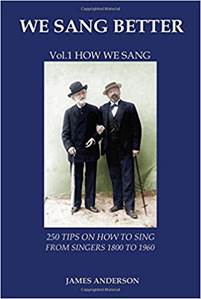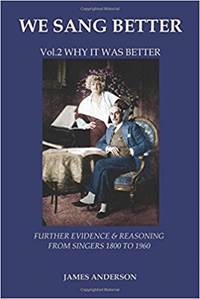

WE SANG BETTER, two volumes by James Anderson


ISBN 978-84-940477-0-1
Click here to order the book
The author’s website : www.singerslegacy.com
Lots of books have been written on the art of singing, some more interesting and more successful than others. This two volume set –totaling over 700 pages!! - is of great interest and recommended to anyone fascintated by vocal technique and singers of the golden age.
Volume 1 is entitled ‘How we sang’ and contains 250 tips on how to sing from singers 1800 to 1960. This volume is 490 pages long, and contains 130 illustrations. In the two volumes of We Sang Better, 200 of the greatest singers explain their art in over 70,000 of their own words. In Volume 1 the singers show you their approach, their ideals, and how they learnt to sing. The author arranges their evidence coherently, in easily followed tips. Their advice was uniform - work patiently on developing your own natural voice, with no forcing. The singers then provide the details by which you grow your voice and acquire a firm but flexible technique. Finally you will have a singing voice that is: • personal • beautiful • easy • accurate • true on the note, and • carries well in a large hall • with clear diction & • the ability to move your audience.
As Verdi said, any art worthy of the name must be natural, spontaneous and simple. These singers explain how they kept to this ideal, staying clear of scientific 'discoveries', over-muscularity, and teachers with set 'methods'. These singers worked with Rossini, Donizetti, Bellini, Auber, Meyerbeer, Weber, Schubert, Mendelssohn, Liszt, Verdi, Wagner, Brahms, Gounod, Massenet, Debussy, Puccini, Strauss, Elgar, etc & kept to nearly all the recommendations that came from the castrati in the previous two centuries.
The author is a musician who has worked for the Arts Council of Great Britain and has run several European Festivals. Regretting the scarcity of supreme singing today, he has spent the last 30 years researching and collating this advice.
Volume 2 (ISBN 978-84-940477-9-4) is entitled ‘Why it was better’ and contains further evidence and reasoning from singers 1800 to 1960. This volume is 260 pages long, and contains 20 illustrations. As Volume 1 made clear, the best singers of this period approached their art and their training gently. They built slowly upon the individual voice granted by nature. Volume 2 gives further proof that many of these singers knew exactly what they were doing and why. They were highly aware that singing can go wrong. But they said if you wanted superlative singing you had to keep approaching it their way. You would never master supreme singing: if you put your trust in scientific ‘discoveries’ or ‘fixes; if you rushed your training or forced; or if you tried to copy some academic ‘style’.
This volume takes evidence from the singers on dozens of topics such as: pressure, exercises, ‘forward’, dans le masque, covering, ‘from the chest’, voix sombrée, portamento, attack, vowel modifications, support, golden ages, keeping up with instrumentalists, listening to others, performances of early music, etc - and also on the question of whether singing is a science, an art, or even something more - something spiritual (think Lauri-Volpi).
Luckily the second volume is blessed with several registers which makes it easy to navigate through the two books. Not only is it well-researched, it is also well-written, reads ‘easily’ and there are hardly any typos or errors. As is often said Battistini never taught (pg. 41) yet Paola Novikova (legendary teacher of George London, Nicolai Gedda etc) studied with him in Berlin. I was also intrigued to read that you actually have to pronounce the ‘z’ in Gilbert Duprez (pg.51). The few typos include ‘Lucia de Lammermoor’ (pg.63) , Kyra Vane instead of Vayne (pg .64 and further)) , Romeo (instead of Roméo) et Juliette, Leonora (pg. 103) instead of Leonore (Fidelio), Pelleas et Melisande for Pelléas et Mélisande (pg .424) and Wilfed Douthitt aka Louis Graveure was of course not Belgian (vol.2,pg 231) .The author now helps young singers through the Singers Legacy website.
Operanostalgia, December 2017